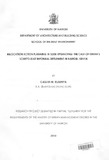| dc.contributor.author | Kusienya, Cassius M. | |
| dc.date.accessioned | 2013-03-19T09:23:32Z | |
| dc.date.issued | 2010 | |
| dc.identifier.citation | Master of urban management | en |
| dc.identifier.uri | http://erepository.uonbi.ac.ke:8080/xmlui/handle/123456789/14601 | |
| dc.description.abstract | Many inhabitants of the slums and informal settlements in developing
countries lack access to adequate and affordable housing and basic
housing services. Poor access to affordable and adequate housing
constraints economic and social development of slum dwellers and
contributes to poverty in such areas. Better housing services can stimulate
economic activities and social improvements of slum dwellers, leading to a
virtuous circle that reduces poverty while improving the lives and livelihoods
of the urban poor. Improving the urban Poor’s access to essential housing
services requires participatory approaches in slum upgrading that involves
all the stakeholders at all levels of the project cycle.
Kibera is arguably one of the largest slums in Africa. It is located southwest of
Nairobi city centre and is sited approximately 5 km away from the city
centre. It is the largest slum in Kenya and comprises of 12 villages; Kianda,
Soweto, Gatwekera, Kisumu Ndogo, Lindi, Laini Saba, Siranga/Undugu, Raila,
Makina and Mashimoni. It has an estimated population of 500,000 people
covering approximately 225 hectares of land. This translates to a density of
about 2000 people per hectare. It holds more than a quarter of Nairobi’s
population. | en |
| dc.description.sponsorship | University of Nairobi | en |
| dc.language.iso | en | en |
| dc.title | Relocation Action Planning in Slum Upgrading: The Case of Kibera's Soweto-East Informal Settlement In Nairobi, Kenya | en |
| dc.title.alternative | The case of kibera’s Soweto-east informal settlement in Nairobi, Kenya | en |
| dc.type | Thesis | en |
| local.publisher | Department of architecture and building science school of the built environment | en |

